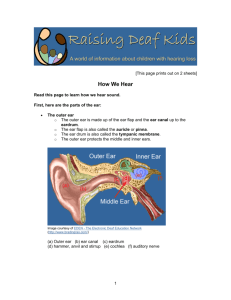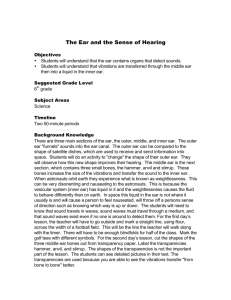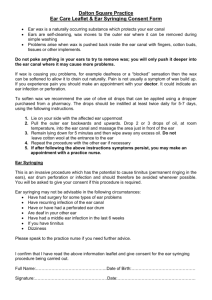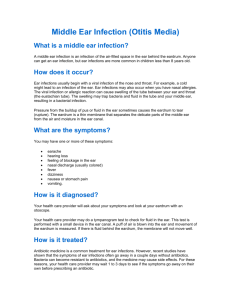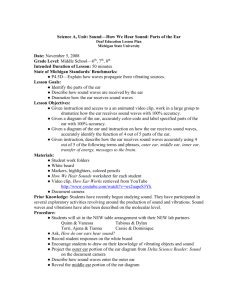2nd Grade Science Words
advertisement
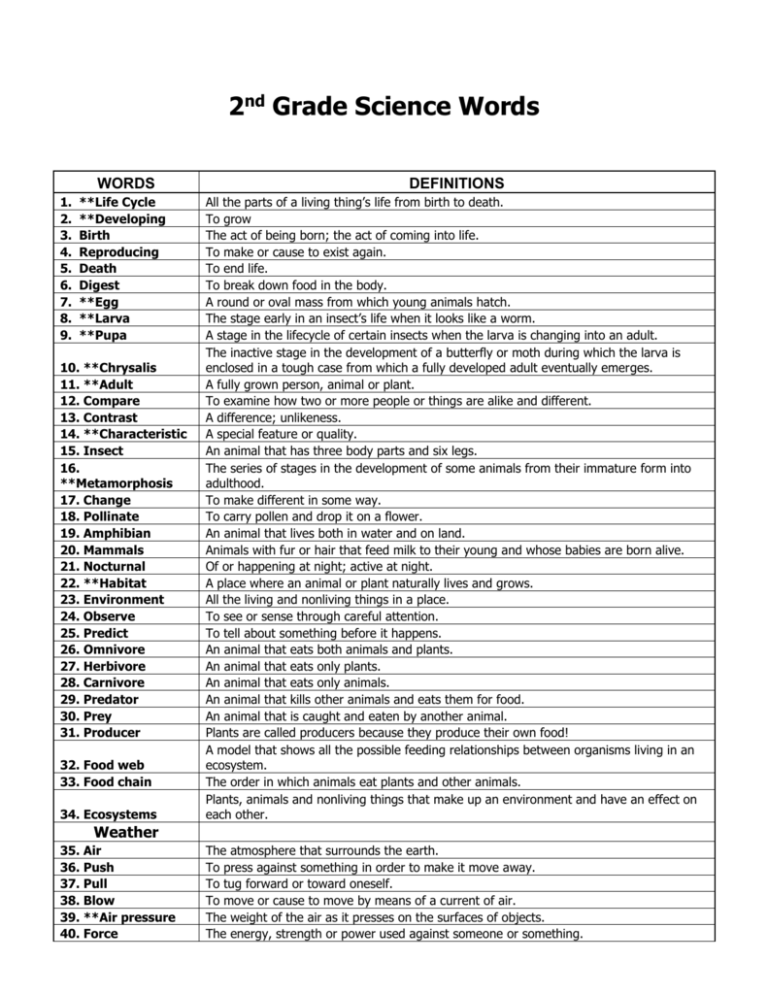
2nd Grade Science Words WORDS 1. 2. 3. 4. 5. 6. 7. 8. 9. **Life Cycle **Developing Birth Reproducing Death Digest **Egg **Larva **Pupa 10. **Chrysalis 11. **Adult 12. Compare 13. Contrast 14. **Characteristic 15. Insect 16. **Metamorphosis 17. Change 18. Pollinate 19. Amphibian 20. Mammals 21. Nocturnal 22. **Habitat 23. Environment 24. Observe 25. Predict 26. Omnivore 27. Herbivore 28. Carnivore 29. Predator 30. Prey 31. Producer 32. Food web 33. Food chain 34. Ecosystems DEFINITIONS All the parts of a living thing’s life from birth to death. To grow The act of being born; the act of coming into life. To make or cause to exist again. To end life. To break down food in the body. A round or oval mass from which young animals hatch. The stage early in an insect’s life when it looks like a worm. A stage in the lifecycle of certain insects when the larva is changing into an adult. The inactive stage in the development of a butterfly or moth during which the larva is enclosed in a tough case from which a fully developed adult eventually emerges. A fully grown person, animal or plant. To examine how two or more people or things are alike and different. A difference; unlikeness. A special feature or quality. An animal that has three body parts and six legs. The series of stages in the development of some animals from their immature form into adulthood. To make different in some way. To carry pollen and drop it on a flower. An animal that lives both in water and on land. Animals with fur or hair that feed milk to their young and whose babies are born alive. Of or happening at night; active at night. A place where an animal or plant naturally lives and grows. All the living and nonliving things in a place. To see or sense through careful attention. To tell about something before it happens. An animal that eats both animals and plants. An animal that eats only plants. An animal that eats only animals. An animal that kills other animals and eats them for food. An animal that is caught and eaten by another animal. Plants are called producers because they produce their own food! A model that shows all the possible feeding relationships between organisms living in an ecosystem. The order in which animals eat plants and other animals. Plants, animals and nonliving things that make up an environment and have an effect on each other. Weather 35. Air 36. Push 37. Pull 38. Blow 39. **Air pressure 40. Force The atmosphere that surrounds the earth. To press against something in order to make it move away. To tug forward or toward oneself. To move or cause to move by means of a current of air. The weight of the air as it presses on the surfaces of objects. The energy, strength or power used against someone or something. 41. **Temperature 42. Wind speed 43. Wind direction 44. **Precipitation 45. Measure 46. Thermometer 47. Anemometer 48. Wind vane 49. Rain gauge 50. **Weather 51. **Water cycle 52. **Water vapor 53. Evaporate 54. Solar 55. Condensation 56. Collection 57. Cirrus 58. Cumulous 59. Stratus 60. Climate 61. Energy 62. Meteorologist 63. Pollution 64. Runoff 65. Humidity The measure of how cold or how hot someone or something is. How fast the wind is blowing. The direction from which the wind is coming. Water that falls to the earth as rain, snow, hail or sleet. To find the size, weight, volume or amount of something. A device used to measure temperature usually by the height of a liquid that expands or contracts inside a slender glass tube. A device used to measure wind speed. A thin, flat moveable piece of wood or metal that points in the direction that the wind is blowing. A device used to measure rainfall. The condition or activity of the atmosphere at any given time or place. The way water moves from the air to the land and back to the air. Water that has changed into gas. To change from a solid or liquid into a gas; to disappear. From or of the sun. The change of a substance from a gas into a liquid through cooling. Things gathered together. A kind of cloud that is thin, feathery, and high in the sky. A kind of cloud that looks like puffy white cotton. A kind of cloud that is low and gray and stretches across the sky. Weather that is typical for a certain place including temperature and amounts of rain or wind. A force having the power to make things move or work. Someone who reports and forecasts weather conditions. Waste that harms land, water, or air. Rainfall not absorbed by soil. Moisture in the air. Sound 66. **Sound 67. **Vibration 68. **Frequency 69. **Pitch 70. **Loudness 71. Instrument 72. **Membrane 73. **Inner Ear 74. **Outer Ear 75. **Eardrum Energy that you hear. A rapid motion back and forth. The rate of a repeating movement. How high or low a sound is. How loud or soft a sound is. A device to make music. A soft tissue inside the ear than helps you hear. The inside part of the ear. The outer part of the ear. The membrane that separates the outer ear and the middle ear and vibrates when sound waves strike it. 76. Vocal Cords 77. Echolocation Membranes at the top of the windpipe that vibrate and make sounds when you talk. Sound waves bouncing off objects to tell their location. Matter 78. Solid 79. Liquid 80. Gas 81. Matter 82. Mass The only form of matter that has a shape of its own. A form of matter that does not have its own shape. The only kind of matter that always fills the space inside a container. What all things are made of. The amount of matter an object has. 83. **States of matter 84. Melting 85. Freezing 86. **Evaporation 87. Vapor 88. Heating 89. Transfer 90. Boiling point 91. Freezing point 92. **Properties 93. **Combine 94. **Separate 95. Reverse 96. **Mixture This can be a liquid, gas, or solid. To change from a solid to a liquid by means of heat. To make a liquid into ice by hardening with cold. The process of water turning into gas. Very small bits of something in the air, especially water. To make or become hot. To cause something to move from one place to another. The point at which water begins to bubble. (212 degrees) The point at which water turns from a liquid to a solid. (32 degrees) A quality of something. To mix or join together. To take apart. To move something so its position is the opposite of what it had been or inside out. Something made up of two or more things.






